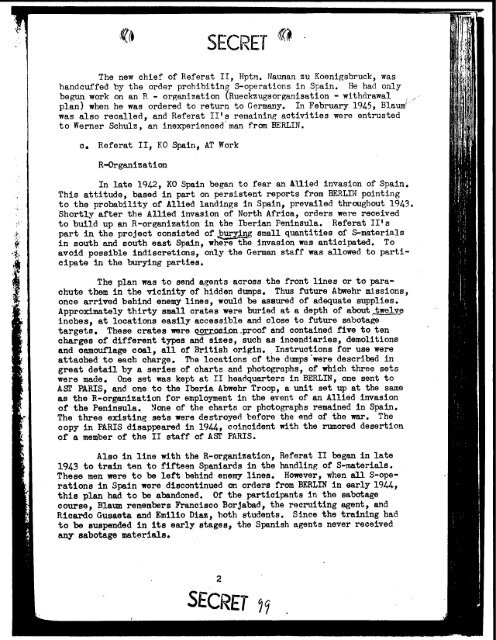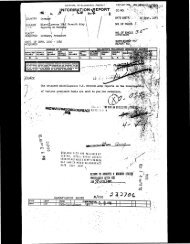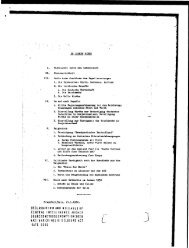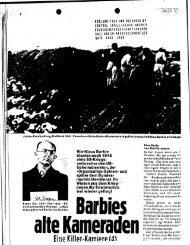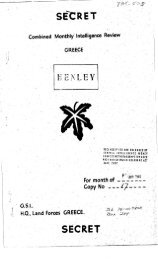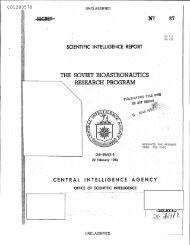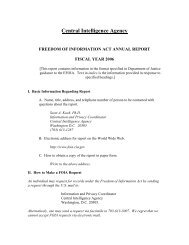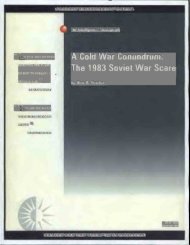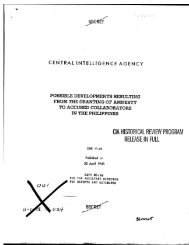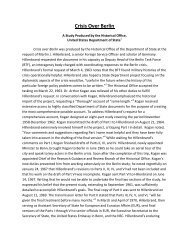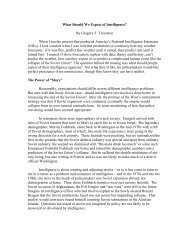RIO 1055 .U51 S-E -C -R--L--T U.S. Army. European Command ...
RIO 1055 .U51 S-E -C -R--L--T U.S. Army. European Command ...
RIO 1055 .U51 S-E -C -R--L--T U.S. Army. European Command ...
You also want an ePaper? Increase the reach of your titles
YUMPU automatically turns print PDFs into web optimized ePapers that Google loves.
SECRET f°<br />
The new chief of Referat II, Hptm. Nauman zu Koenigsbruck, was<br />
handcuffed by the order prohibiting S-operations in Spain. He had only<br />
begun work on an P. - organization (Rueckzugsorganisation - withdrawal<br />
plan) when he was ordered to return to Germany. In February 1945, Blaumr<br />
was also recalled, and Referat II's remaining activities were entrusted<br />
to Werner Schulz, an inexperienced manfrom BERLIN.<br />
(3. Referat II, KO Spain, AT Work<br />
R -Organization<br />
In late 1942, KO Spain began to fear an Allied invasion of Spain.<br />
This attitude, based in part on persistent reports from BERLIN pointing<br />
to the probability of Allied landings in Spain, prevailed throughout 1943.<br />
Shortly after the Allied invasion of North Africa, orders were received<br />
to build up an R-organization in the Iberian Peninsula. Referat II's<br />
part in the project consisted of blirving small quantities of S-materials<br />
in south and south east Spain, where the invasion was anticipated. To<br />
avoid possible indiscretions, only the German staff was allowed to participate<br />
in the burying parties.<br />
The plan was to send agents across the front lines or to parachute<br />
them in the vicinity of hidden dumps. Thus future Abwehr missions,<br />
once arrived behind enemy lines, would be assured of adequate supplies.<br />
Approximately thirty small crates were buried at a depth of about twelve<br />
inches, at locations easily accessible and close to future sabotage<br />
targets. These crates were mrosion_proof and contained five to ten<br />
charges of different types and sizes, such as incendiaries, demolitions<br />
and camouflage coal, all of British origin. .Instructions for use were<br />
attached to each charge. The locations of the dumps'were described in<br />
great detail by a series of charts and photographs, of which three sets<br />
were made. One set was kept at II headquarters in BERLIN, one sent to<br />
AST PARIS, and one to the Iberia Abwehr Troop, a unit set up at the same<br />
as the R-organization for employment in the event of an Allied invasion<br />
of the Peninsula. None of the charts or photographs remained in Spain.<br />
The three existing sets were destroyed before the end of the war. The<br />
copy in PARIS disappeared in 1944, coincident with the rumored desertion<br />
of a member of the II staff of AST PARIS.<br />
Also in line with the R-organization, Referat II began in late<br />
1943 to train ten to fifteen Spaniards in the handling of S-materials.<br />
These men were to be left behind enemy lines. However, when all S-operations<br />
in Spain were discontinued on orders from BERLIN in early 1944,<br />
this plan had to be abandoned. Of the participants in the sabotage<br />
course, Blaum remembers Francisco Borjabad, the recruiting agent, and<br />
Ricardo Gusaeta and Emilio Diaz, both students. Since the training had<br />
to be suspended in its early stages, the Spanish agents never received<br />
any sabotage materials.<br />
2<br />
SECRET


